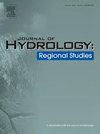Structural sediment connectivity dynamics in a representative watershed of the southern China’s red soil region: Response to land use/cover changes
IF 5
2区 地球科学
Q1 WATER RESOURCES
引用次数: 0
Abstract
Study region
Red soil region of southern China
Study focus
Land use/cover changes significantly affect the ecosystem’s potential for sediment detachment and transport capacity. These impacts can be manifested through variations in sediment connectivity, which reflects the continuity and strength of runoff and sediment pathways at a given point in time. Combining the sediment connectivity index (IC) with observed sediment data, this study assessed the dynamics of structural sediment connectivity and its response to land use/cover changes in a representative watershed of southern China's red soil region.
New hydrological insight for the region
Over four decades of soil erosion control, land use and landscape patterns have changed minimally, but the vegetation cover has increased significantly. The mean IC values were −0.88, −0.87 and −3.77 in 1986, 2000 and 2019, respectively, indicating a great decrease in structural sediment connectivity. Croplands and highly fragmented landscape patterns can lead to high IC values. The changes in vegetation cover were the direct cause of IC reduction, which resulted in temporal variations in structural sediment connectivity. These variations aligned chronologically with regional development patterns and policies. Sediment connectivity changes became the main factor controlling sediment yield in the watershed from 2001 to 2020, reducing it by 57.56 % compared to 1982–1995 period. These findings provide spatial guidance for optimizing landscape patterns and cropland management to mitigate sediment connectivity hotspots in red soil regions.
中国南方红壤区代表性流域结构泥沙连通性动态:对土地利用/覆被变化的响应
南方红壤区土地利用/覆被变化显著影响生态系统泥沙分离潜力和输沙能力。这些影响可以通过泥沙连通性的变化来体现,泥沙连通性反映了某一特定时间点径流和泥沙路径的连续性和强度。结合沉积物连通性指数(IC)和实测泥沙资料,研究了中国南方红壤区代表性流域结构沉积物连通性动态及其对土地利用/覆被变化的响应。经过40多年的水土流失控制,土地利用和景观格局变化不大,但植被覆盖显著增加。1986年、2000年和2019年的IC平均值分别为- 0.88、- 0.87和- 3.77,表明构造沉积物连通性显著降低。农田和高度破碎化的景观格局会导致高的生态生态价值。植被覆盖的变化是IC减小的直接原因,IC减小导致了构造沉积物连通性的时间变化。这些变化按时间顺序与区域发展模式和政策一致。2001 - 2020年泥沙连通性变化成为控制流域产沙的主要因素,与1982-1995年相比减少了57.56 %。研究结果可为红壤区景观格局优化和农田管理提供空间指导。
本文章由计算机程序翻译,如有差异,请以英文原文为准。
求助全文
约1分钟内获得全文
求助全文
来源期刊

Journal of Hydrology-Regional Studies
Earth and Planetary Sciences-Earth and Planetary Sciences (miscellaneous)
CiteScore
6.70
自引率
8.50%
发文量
284
审稿时长
60 days
期刊介绍:
Journal of Hydrology: Regional Studies publishes original research papers enhancing the science of hydrology and aiming at region-specific problems, past and future conditions, analysis, review and solutions. The journal particularly welcomes research papers that deliver new insights into region-specific hydrological processes and responses to changing conditions, as well as contributions that incorporate interdisciplinarity and translational science.
 求助内容:
求助内容: 应助结果提醒方式:
应助结果提醒方式:


